|
Dahuichang
Sujiatun
Tiefa Yuanbaoshan
Chengde
Part 4: JiTong Tielu
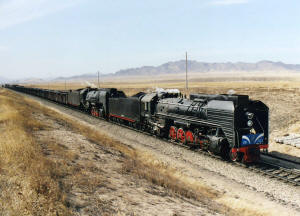 |
| The world famous JiTong Tielu, last railroad in the world
built in 1995 using steam locomotives, provides a look back into our
own past here in the USA. The scenery in this part of Inner Mongolia
reminds me of Wyoming, Colorado, or Northern Mexico, and my
imagination now has many less blanks to fill in when I think about
the old days. |
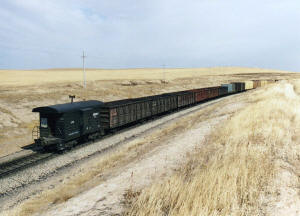 |
| With Jing Ping Pass dieselized because of political
pressure, and in spite of the proven economies of steam in regular
service, the last QJs were concentrated on a section of line about
100 miles long between Chabuga and the HQ town of Daban. All trains
were steam during my visit, with most having two QJs on the head end
and a proper caboose on the tail. |
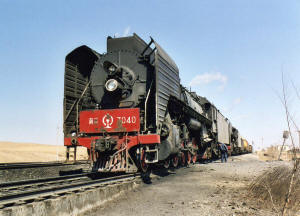 |
| The first station of any size east of Daban is the water
and fire cleaning stop with two passing tracks
guarded by semaphores
at Gulumanhan. QJ 7040 is a personal favorite. |
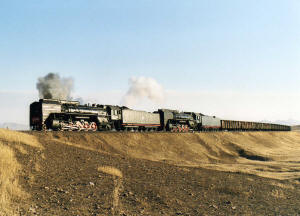 |
| Just east of Daban a standard issue JiTong freight gets a
good roll on things. After a few days in this
area, being chauffeured around to all the good photo spots in a nice
SUV with all our stuff, kept up to date by internet and cell phone,
with the few quiet times taken up by coffee breaks and noodles and
Daliyuan cakes, we got VERY spoiled. (I'd say I've been more spoiled
in Guatemala, but we had to park the train first.) We got so spoiled
that everybody in our party actually nodded off, and we nearly slept
through a train with doubled headed QJs !!! We were too slow and
groggy to get our cameras functioning, but we did manage to stagger
down to trackside and watch them chug by. |
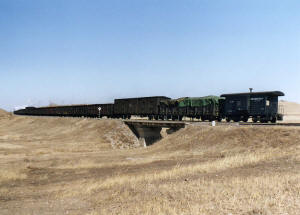 |
| I didn't see a single breakdown or delay caused by steam
power during my two weeks in China. You can be sure that it was a
smooth trip to Chabuga for this rear end crew. |
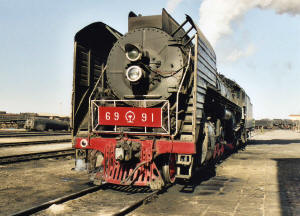 |
|
The Train that Wouldn't Die
QJ 6991, like most other
active QJs is from the last several years of production in the mid
80s, numbered in the 6900, 7000, and 7100 series.
Recent pictures don't show steam being worked on this spot
outside the shops in Daban any more, and most of the QJs in the
background reduced to boilers sitting on the ground. My guess is
that they are being saved for stationary heating plants. |
 |
| Another deadline is located to the left, and reports are
that the coal pile and ash pits are gone now. It
had been our original intention to run this story in April, which
would have given any stragglers a little bit of time to come see
this for themselves. Without reciting all the gruesome details, I
can say that computer Hell was responsible for the six month delay
in posting. While JiTong gets closer to being dieselized every day,
it certainly isn't the last place on earth with active QJs, even
though it was the biggest modern day steam line. Steam is far enough
from dead in China, that I've already made plans to do it again next
year. |
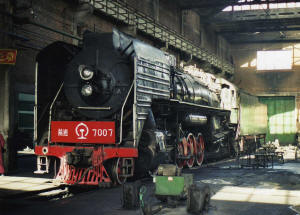 |
| Once again, videos taken a year or two ago show this shop
full of busy employees. On this day, QJ 7007 was getting a new crown
brass, or at least they had the #2 driving box out. Most activity
was concentrated on trying to sell us train souvenirs, some of which
were genuine. |
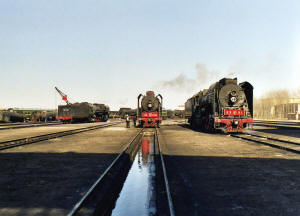 |
| They say there's diesel fuel tanks and diesels out here
now. |
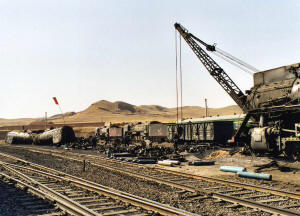 |
| Chinese flag still fly's from the remains of China's
finest. One of the refinements incorporated into
the QJ class was the placement of the dry pipe above the boiler
shell, connecting the steam dome directly to a throttle body
combined with superheater header in the smokebox. This not only
allowed more steam storage in the boiler barrel, but it did away
with the chore of opening the dome, removing the throttle, bolting a
hydro plate over the dry pipe, and sealing up the dome before a
hydro test, then repeating these steps in reverse before the engine
could be used. This arrangement is now visible on the remaining
boilers, and indicates probable reuse. |
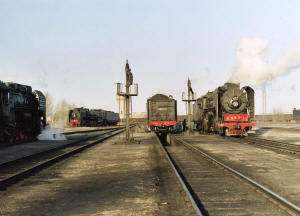 |
| A hundred feet from where the previous picture was taken
were five live QJs. Some of them are still going. |
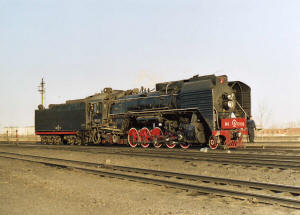 |
|
QJ 6998 smartly adorned with the red star. |
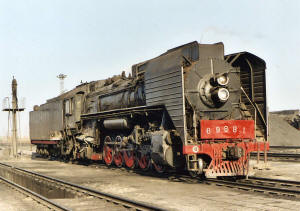 |
| There were over a dozen live QJs at Daban that day, but
time is running out very fast. Of course, it IS 2005. |
 |
| Whether the new diesels are capable of scaring livestock
like these two QJs is doubtful. |
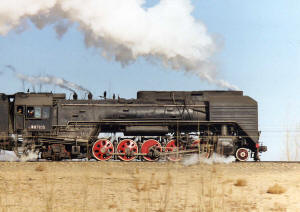 |
| In my opinion, QJs are faster than they have been
reported, and faster than they look. The fact that they are a bit on
the skinny side compared to many American 2-10-2s means that they
can run on lighter track and have less weight slinging around on the
crankpins. |
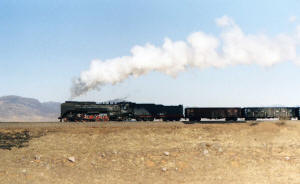 |
| Only a few trains were dispatched with one engine, but
sometimes the two engines split the train up into two cuts so they
could switch two locations at once. |
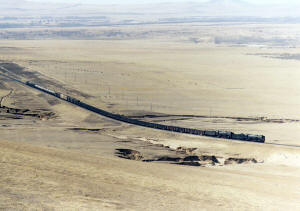 |
| While the scenery on this section of line is less
spectacular than it is west of Daban, it was still very beautiful to
climb up on a hill surrounded on three sides by a busy QJ powered
railroad, and pass the time watching trains. I'm so glad I went in
the spring --- thirteen years of railroading in blizzards while I
worked for BN was enough for me. |
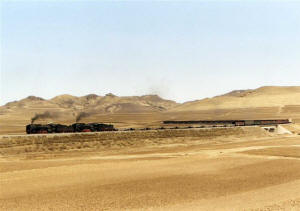 |
| In about the middle of the division is the town of Lindong,
a mile or two west of this bridge. |
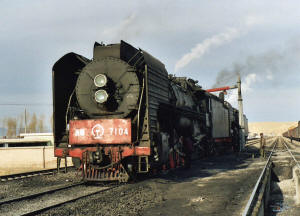 |
| Lindong is the biggest station on the Daban/Chabuga
division. These engines had just arrived with a freight from Chabuga,
cut off their train, took water and returned light to Daban. |
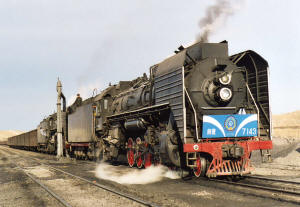 |
| Relief power from Chabuga arrives, tops off the water, and
proceeds with a genuine road switching exhibition. Each engine took
half the train and switched opposite ends of the yard simultaneously,
doing the job more than twice as fast as a single diesel can do it. |
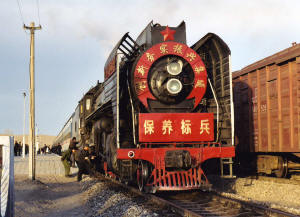 |
| Only a week after returning from Sujiatun, fully decorated
QJ 6911 was in top form hauling the daily passenger train between
Daban and Chabuga. A 5 minute station stop is time for some knocking
and greasing and looking around her running gear.
The engine was retired
on August 15th with a ceremony in Daban. It seems likely that she
will be held for special events, as her appearance is impeccable and
she is just broke in good (I know that's bad grammar, but that's how
railroaders say it). |
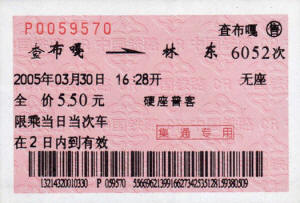 |
| Our next to last day on the JiTong allowed me the chance to ride
behind the QJ 6911 from Chabuga to Lindong. The ride was extremely nice, and a
deadheading JiTong driver offered to guide us, protecting us from the overly
aggressive souvenir vendors. We got on the diner, sat down at a table across
from a nice English gentleman and his son, and ordered some cold Harbins, total
price about a dollar for my train ticket AND a beer. Then these guys started in
on us big time, and this driver opened up his grip, which was full of JiTong
junk to sell. Remember, I'm a railroader too, so I had
to put a stop to the foolishness. I started going
through their pockets, and giving the business right
back to them, figuring quite correctly that they could
understand what I was saying plainly enough. After I
took the cigarettes out of the driver's pocket and
offered everybody one, then bummed a light from him,
they laid off a bit. This driver ended up needing protection from me and I ended up
getting a bunch more nice souvenirs for a pretty reasonable price.
It was all in fun of course. I managed to
hold onto my ticket (above) from this ride, and I shamed those guys into actually GIVING
me this China Rail pocket holder (below), which I believe is intended for safe storage
of a locomotive driver's license. |
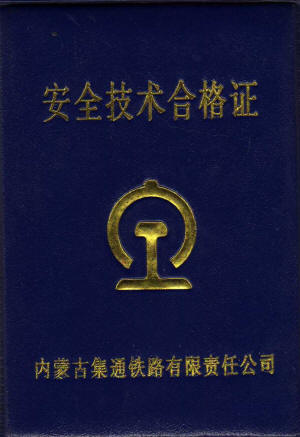 |
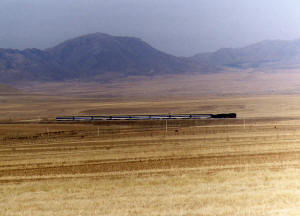 |
| I still think that QJs are faster than folks say they are,
because I took many pictures of this train at 1/500th second shutter
speed, but it wasn't fast enough to stop QJ 6911 from the usual line
side angles. The only views I got of the last fancy, sleeper
equipped, dining car equipped, steam powered, mainline, passenger
train in regular service in the whole ding-blasted world that
weren't blurred were this morning shot near
Dariqiga, and the
previous shot in Lindong station. A 1/500th second exposure got good
results of recent UP 3985 movements, so I figured I was good to go.
Guess not. |
 |
| An easy shot now right off the brand new Trans Mongolian
Highway, which generally parallels the JiTong. |
Dahuichang
Sujiatun
Tiefa Yuanbaoshan
Chengde
return to articles index |